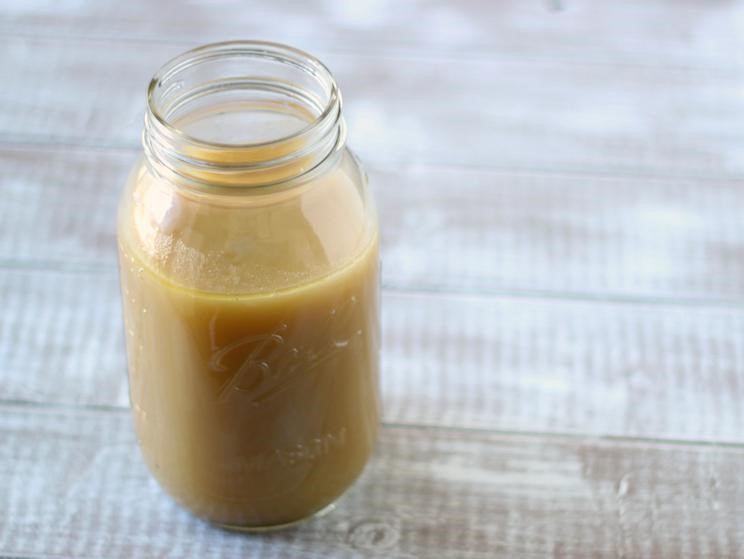Broth is an ancient food that traditional cultures and trained chefs have been using for ages, and it has recently regained popularity and was even called “trendy” on the Today show.
A true “what’s old is new again” story that our great grandmothers would probably laugh about, modern culture is finally catching up to what traditional cultures have known for years… that broth is an inexpensive and versatile source of nutrients.
Years ago, many families kept a pot of broth simmering on the hearth. This provided an easy base for soups and other recipes and also a way to keep the broth fresh before the invention of refrigerators. It’s one of the many traditional foods that we’ve largely forgotten in modern culture, but I’m glad to see it making a come back.
Broth is easily and simply made by boiling bones (beef, chicken, fish, etc) in water with an acid (like vinegar) and optional spices, vegetables and herbs. Broth can boil for as little as 4 hours or up to 48 (or more as traditional cultures did). In case you need some convincing, these are some of the many reasons to consume broth regularly:
Nutrient Absorption
Broth is wonderful for absorption in two ways
1) It is a source of bio-available nutrients in an easy-to-digest form.
2) Its amino acid structure and high gelatin content makes it soothing and healing for the gut and enhances the absorption of nutrients from other foods as well
Supports Hair, Skin, Nails & Joints
Broth contains the collagen, which supports hair, skin and nail health. It also contains glucosamine, chondroitin sulphates and other compounds that support joint health.
Bone broth provides the amino acids needed for collagen production. Collagen keeps the skin smooth, firm and reduces wrinkles. Heather of Mommypotamus quotes a study on mice where one group was exposed to sunlight (increasing time and intensity) and another group was exposed to sunlight (same way) but received supplemental gelatin. In her words:
When results were measured, “mice exposed to the light without the gelatin had a 53% average decrease in the collagen content of their skin, compared to the mice that received no ultraviolet light exposure at all. Astonishingly, the mice that were exposed to the light, but also fed gelatin had no collagen decrease at all. They actually had an average collagen increase of 17%.”The gelatin in bone broth also helps strengthen hair and nails and speed their growth.
Necessary Amino Acids
Broth is an excellent source of several essential amino acids that are often difficult to get from diet alone:
Proline: A precursor for hydroxyproline, which the body uses to make collagen, proline helps the body break down proteins and helps improve skin elasticity and smoothness (and avoiding wrinkles). It is often recommended for its benefits to the heart, including keeping arteries from stiffening.
Glycine: Necessary for DNA and RNA synthesis and digestive health. It is used for the production of glutathione, for blood sugar regulation and digestion (though bile salt regulation). Dr. Sarah Ballantyne, “Glycine also enhances muscle repair/growth by increasing levels of creatine and regulating Human Growth Hormone secretion from the pituitary gland.”
Arginine: Helpful for proper kidney function, wound healing and proper kidney function. There is some evidence that arginine is helpful in keeping the arteries supple and improving heart health, though more study is needed.
Glutamine: L-glutamine in gut health and how to use it properly. Bone broth is an excellent source of glutamine and is recommended (required) on the GAPS protocol
It is important to note that these amino acids are not technically considered “essential” since the body does make them itself. Since they are only made in small amounts in the body, much of the research I’ve read suggests that it is beneficial to consume them from dietary sources as well.
Gut and Immune Health
Chicken soup is a timeless remedy for illness, but modern research is starting to understand its role in immune health. As we now understand that much of the immune system is in the gut, broth is especially helpful because its high gelatin/collagen content supports gut health and its amino acids help reduce inflammation.
Dr. Campbell McBride, author of Gut and Psychology Syndrome says that gelatin helps “heal and seal” the gut, and in doing so is helpful for reversing leaky gut syndrome and digestive problems.
Broth vs Bone Broth vs Stock
Nourished Kitchen provides a great explanation of the difference between these terms:
Broth is typically made with meat and can contain a small amount of bones (think of the bones in a fresh whole chicken). Broth is typically simmered for a short period of time (45 minutes to 2 hours). It is very light in flavor, thin in texture and rich in protein. Stock is typically made with bones and can contain a small amount of meat (think of the meat that adheres to a beef neck bone). Often the bones are roasted before simmering them as this simple technique greatly improves the flavor. Beef stocks, for example, can present a faint acrid flavor if the bones aren’t first roasted. Stock is typically simmered for a moderate amount of time (3 to 4 hours). Stock is rich in minerals and gelatin.
Bone Broth is typically made with bones and can contain a small amount of meat adhering to the bones. As with stock, bones are typically roasted first to improve the flavor of the bone broth. Bone broths are typically simmered for a very long period of time (often in excess of 24 hours). This long cooking time helps to remove as many minerals and nutrients as possible from the bones. At the end of cooking, so many minerals have leached from the bones and into the broth that the bones crumble when pressed lightly between your thumb and forefinger.
How to Use Broth
Broth is extremely versatile and many chefs use it as a base for soups, gravies, sauces and more.
Here are some great ways to use broth:
-As a base for soups and stews
-In a mug by itself as a warm drink
-As a base for gravy and sauce
-Use it to cook veggies in for extra nutrients
-Dehydrate to make your own bouillon powder
-Also, gelatin powder can be use to make healthy snacks and foods besides broth.
Where to Get Broth
In my opinion, the best way to get broth is to make it yourself. This is the least expensive and most nutrient dense way to get broth if you can find quality (grass fed, organic) bones locally.
If you can’t or just don’t want to make broth, there are now some places that you can order it online and have it shipped.
Sources:
Chest. 2000 Oct;118(4):1150-7
http://www.westonaprice.org/health-topics/why-broth-is-beautiful-
essential-roles-for-proline-glycine-and-gelatin/
Study: Efficacy of glutamine-enriched enteral nutrition in an
experimental model of mucosal ulcerative colitis.
Study: Glutamine and the preservation of gut integrity
Written by: Malia Weinhagen, Whole Body Nutrition and Lifestyle Coaching



 She’s a Mom, has Doctorate in Chiropractic and loves helping people move from pain back to a healthy and active lifestyle.
She’s a Mom, has Doctorate in Chiropractic and loves helping people move from pain back to a healthy and active lifestyle.